Report on Human Resource Management Policies at IBM Corporation
VerifiedAdded on 2021/06/18
|12
|2785
|44
Report
AI Summary
This report provides an analysis and evaluation of Human Resource Management (HRM) policies and practices within IBM Corporation. It examines various aspects of HRM, including recruitment, employee engagement, staff performance, operational health and safety, diversity management, retention, and industrial relations. The report draws information from the company website and employee records, and it also provides a theoretical background of HRM, emphasizing its strategic role in the workplace and its impact on organizational performance. The report also discusses the importance of HRM practices in enhancing employee capabilities, fostering a positive work environment, and achieving business objectives. References from various researchers and authors are also included in the report.
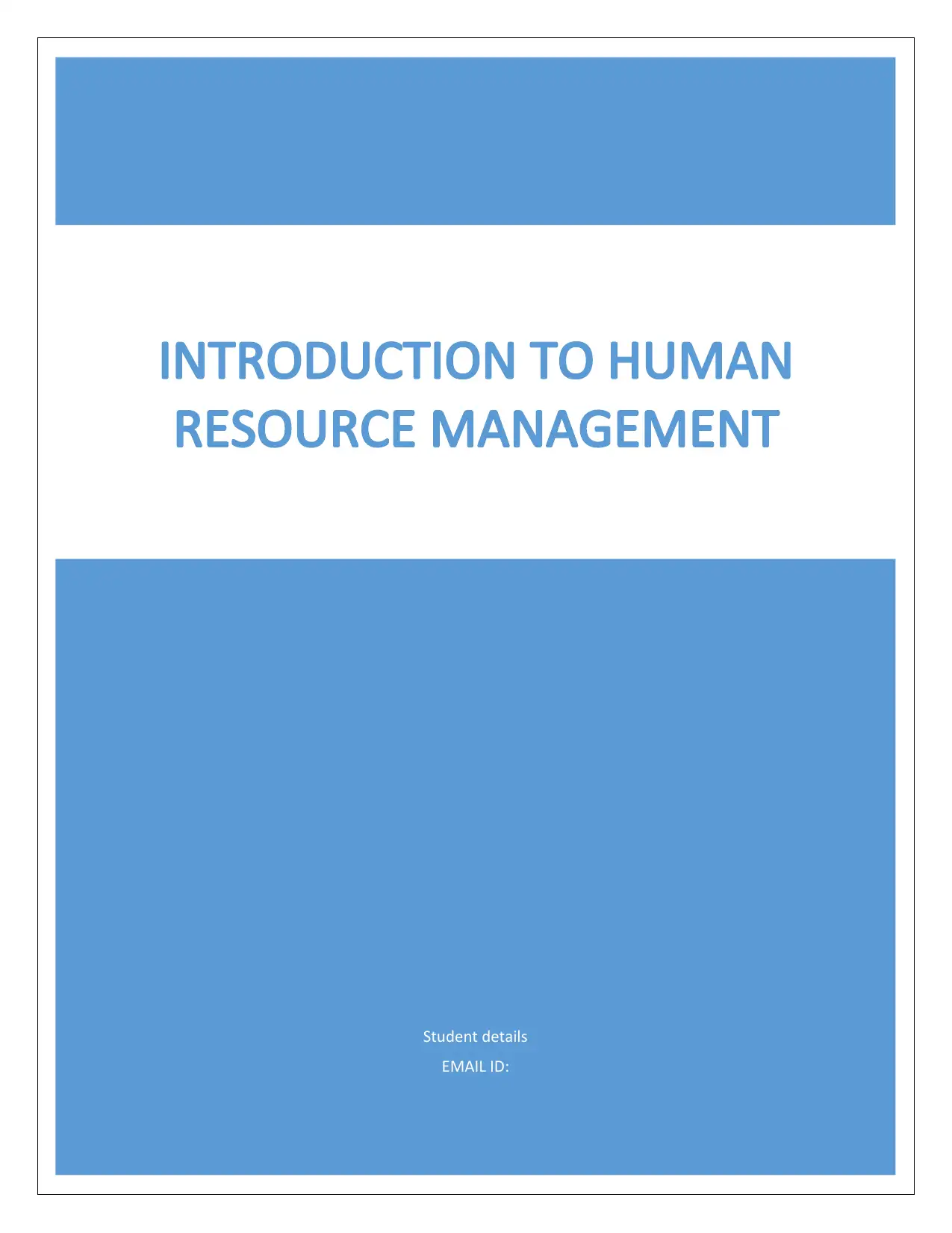
Student details
EMAIL ID:
INTRODUCTION TO HUMAN
RESOURCE MANAGEMENT
EMAIL ID:
INTRODUCTION TO HUMAN
RESOURCE MANAGEMENT
Paraphrase This Document
Need a fresh take? Get an instant paraphrase of this document with our AI Paraphraser
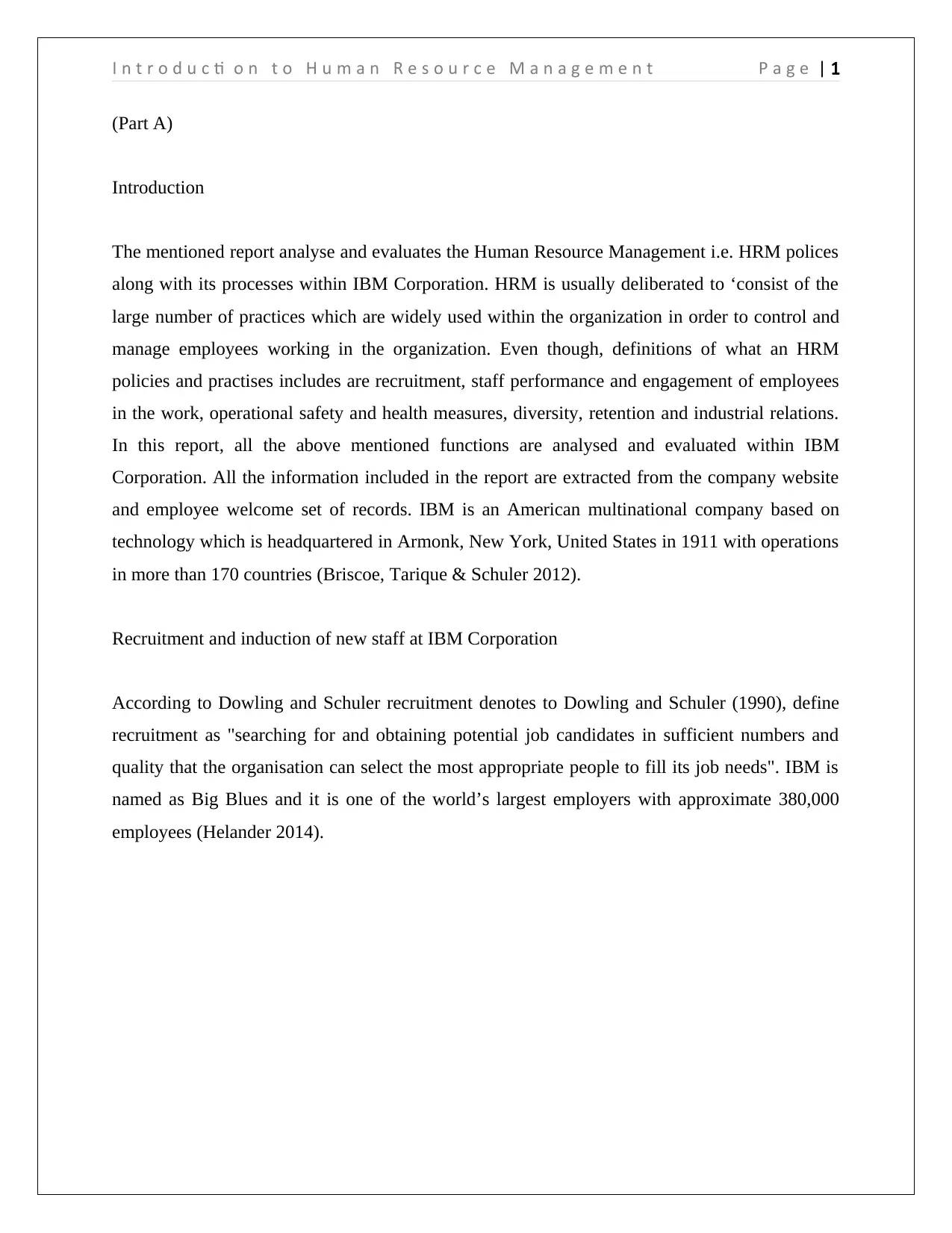
I n t r o d u c ti o n t o H u m a n R e s o u r c e M a n a g e m e n t P a g e | 1
(Part A)
Introduction
The mentioned report analyse and evaluates the Human Resource Management i.e. HRM polices
along with its processes within IBM Corporation. HRM is usually deliberated to ‘consist of the
large number of practices which are widely used within the organization in order to control and
manage employees working in the organization. Even though, definitions of what an HRM
policies and practises includes are recruitment, staff performance and engagement of employees
in the work, operational safety and health measures, diversity, retention and industrial relations.
In this report, all the above mentioned functions are analysed and evaluated within IBM
Corporation. All the information included in the report are extracted from the company website
and employee welcome set of records. IBM is an American multinational company based on
technology which is headquartered in Armonk, New York, United States in 1911 with operations
in more than 170 countries (Briscoe, Tarique & Schuler 2012).
Recruitment and induction of new staff at IBM Corporation
According to Dowling and Schuler recruitment denotes to Dowling and Schuler (1990), define
recruitment as "searching for and obtaining potential job candidates in sufficient numbers and
quality that the organisation can select the most appropriate people to fill its job needs". IBM is
named as Big Blues and it is one of the world’s largest employers with approximate 380,000
employees (Helander 2014).
(Part A)
Introduction
The mentioned report analyse and evaluates the Human Resource Management i.e. HRM polices
along with its processes within IBM Corporation. HRM is usually deliberated to ‘consist of the
large number of practices which are widely used within the organization in order to control and
manage employees working in the organization. Even though, definitions of what an HRM
policies and practises includes are recruitment, staff performance and engagement of employees
in the work, operational safety and health measures, diversity, retention and industrial relations.
In this report, all the above mentioned functions are analysed and evaluated within IBM
Corporation. All the information included in the report are extracted from the company website
and employee welcome set of records. IBM is an American multinational company based on
technology which is headquartered in Armonk, New York, United States in 1911 with operations
in more than 170 countries (Briscoe, Tarique & Schuler 2012).
Recruitment and induction of new staff at IBM Corporation
According to Dowling and Schuler recruitment denotes to Dowling and Schuler (1990), define
recruitment as "searching for and obtaining potential job candidates in sufficient numbers and
quality that the organisation can select the most appropriate people to fill its job needs". IBM is
named as Big Blues and it is one of the world’s largest employers with approximate 380,000
employees (Helander 2014).
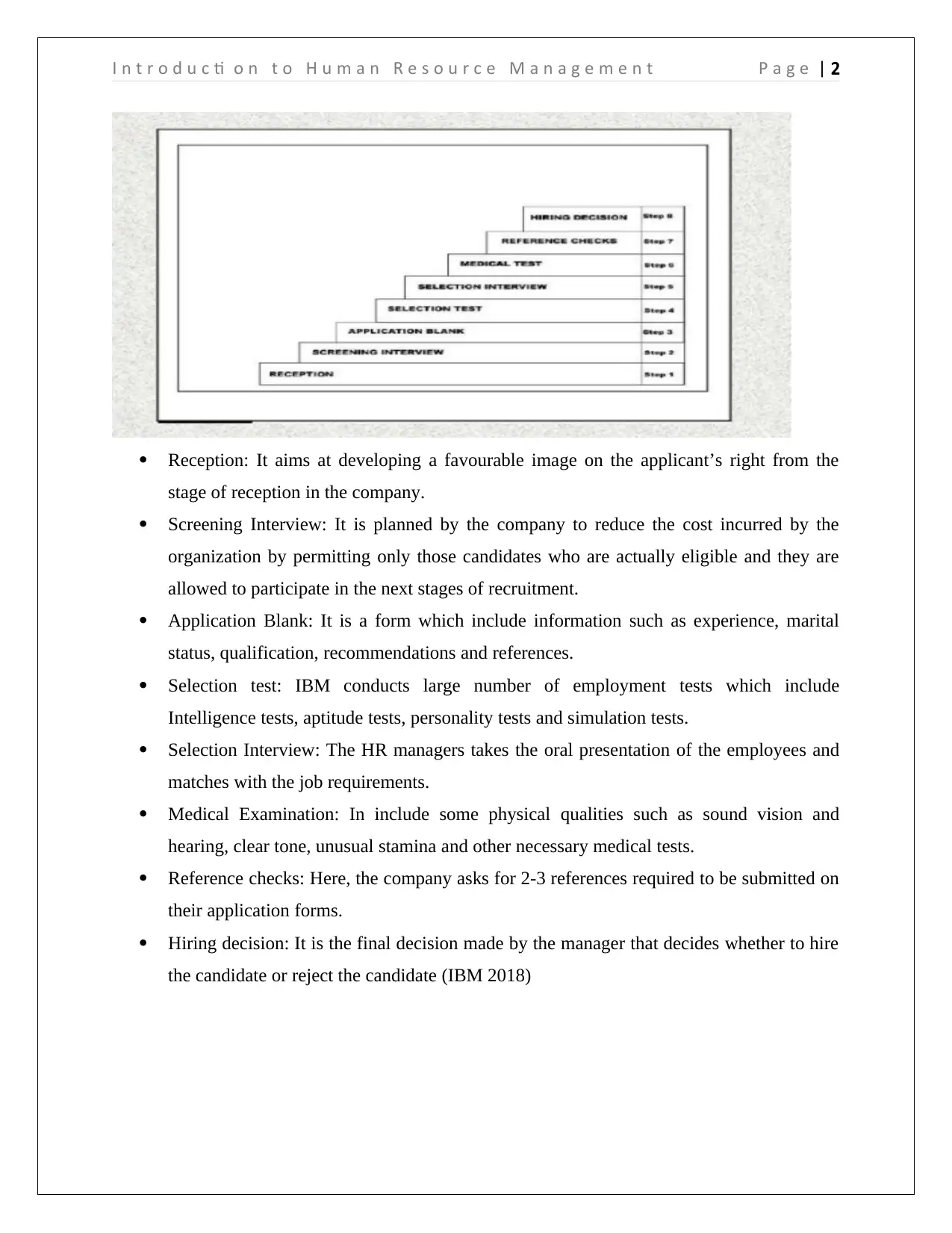
I n t r o d u c ti o n t o H u m a n R e s o u r c e M a n a g e m e n t P a g e | 2
Reception: It aims at developing a favourable image on the applicant’s right from the
stage of reception in the company.
Screening Interview: It is planned by the company to reduce the cost incurred by the
organization by permitting only those candidates who are actually eligible and they are
allowed to participate in the next stages of recruitment.
Application Blank: It is a form which include information such as experience, marital
status, qualification, recommendations and references.
Selection test: IBM conducts large number of employment tests which include
Intelligence tests, aptitude tests, personality tests and simulation tests.
Selection Interview: The HR managers takes the oral presentation of the employees and
matches with the job requirements.
Medical Examination: In include some physical qualities such as sound vision and
hearing, clear tone, unusual stamina and other necessary medical tests.
Reference checks: Here, the company asks for 2-3 references required to be submitted on
their application forms.
Hiring decision: It is the final decision made by the manager that decides whether to hire
the candidate or reject the candidate (IBM 2018)
Reception: It aims at developing a favourable image on the applicant’s right from the
stage of reception in the company.
Screening Interview: It is planned by the company to reduce the cost incurred by the
organization by permitting only those candidates who are actually eligible and they are
allowed to participate in the next stages of recruitment.
Application Blank: It is a form which include information such as experience, marital
status, qualification, recommendations and references.
Selection test: IBM conducts large number of employment tests which include
Intelligence tests, aptitude tests, personality tests and simulation tests.
Selection Interview: The HR managers takes the oral presentation of the employees and
matches with the job requirements.
Medical Examination: In include some physical qualities such as sound vision and
hearing, clear tone, unusual stamina and other necessary medical tests.
Reference checks: Here, the company asks for 2-3 references required to be submitted on
their application forms.
Hiring decision: It is the final decision made by the manager that decides whether to hire
the candidate or reject the candidate (IBM 2018)
⊘ This is a preview!⊘
Do you want full access?
Subscribe today to unlock all pages.

Trusted by 1+ million students worldwide
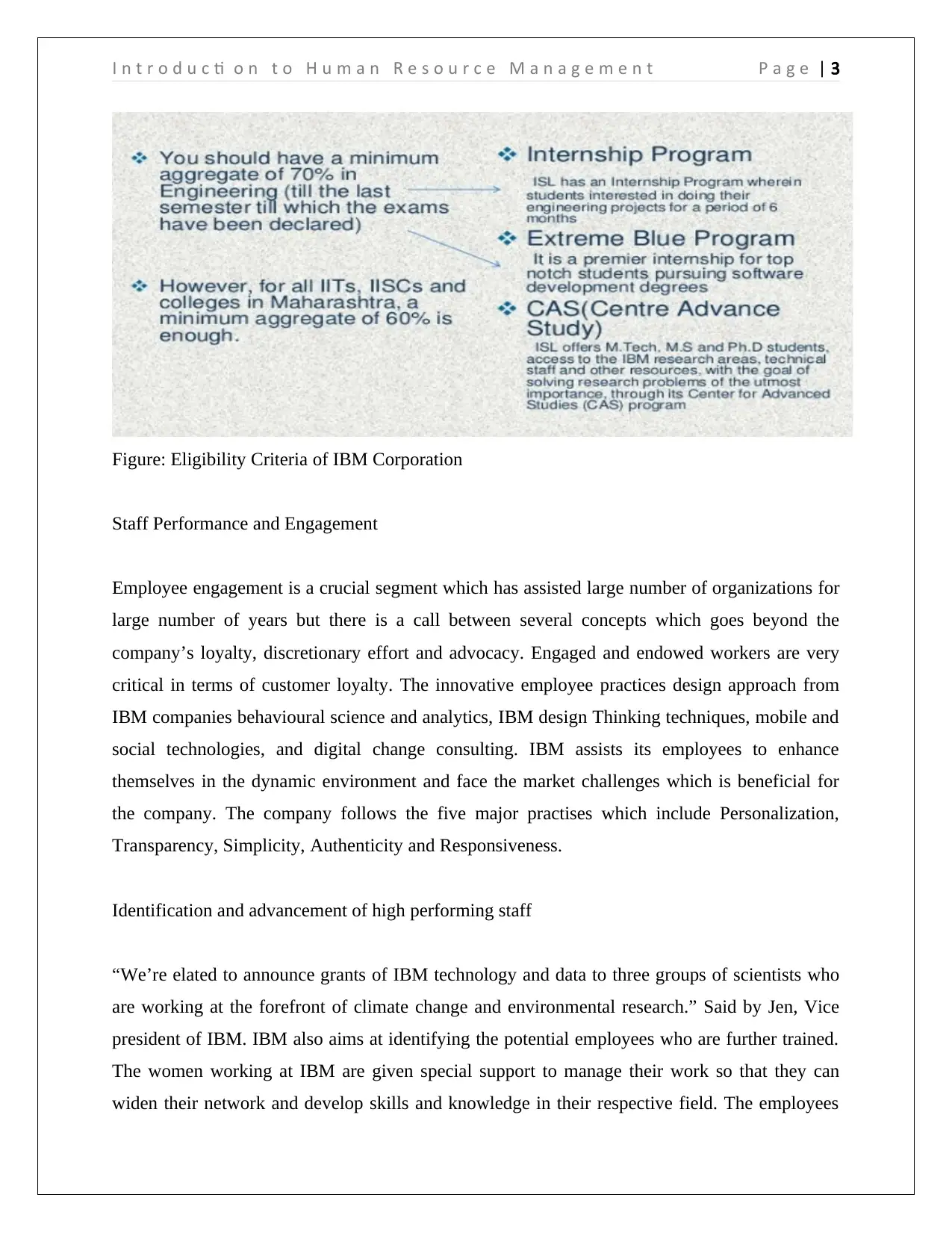
I n t r o d u c ti o n t o H u m a n R e s o u r c e M a n a g e m e n t P a g e | 3
Figure: Eligibility Criteria of IBM Corporation
Staff Performance and Engagement
Employee engagement is a crucial segment which has assisted large number of organizations for
large number of years but there is a call between several concepts which goes beyond the
company’s loyalty, discretionary effort and advocacy. Engaged and endowed workers are very
critical in terms of customer loyalty. The innovative employee practices design approach from
IBM companies behavioural science and analytics, IBM design Thinking techniques, mobile and
social technologies, and digital change consulting. IBM assists its employees to enhance
themselves in the dynamic environment and face the market challenges which is beneficial for
the company. The company follows the five major practises which include Personalization,
Transparency, Simplicity, Authenticity and Responsiveness.
Identification and advancement of high performing staff
“We’re elated to announce grants of IBM technology and data to three groups of scientists who
are working at the forefront of climate change and environmental research.” Said by Jen, Vice
president of IBM. IBM also aims at identifying the potential employees who are further trained.
The women working at IBM are given special support to manage their work so that they can
widen their network and develop skills and knowledge in their respective field. The employees
Figure: Eligibility Criteria of IBM Corporation
Staff Performance and Engagement
Employee engagement is a crucial segment which has assisted large number of organizations for
large number of years but there is a call between several concepts which goes beyond the
company’s loyalty, discretionary effort and advocacy. Engaged and endowed workers are very
critical in terms of customer loyalty. The innovative employee practices design approach from
IBM companies behavioural science and analytics, IBM design Thinking techniques, mobile and
social technologies, and digital change consulting. IBM assists its employees to enhance
themselves in the dynamic environment and face the market challenges which is beneficial for
the company. The company follows the five major practises which include Personalization,
Transparency, Simplicity, Authenticity and Responsiveness.
Identification and advancement of high performing staff
“We’re elated to announce grants of IBM technology and data to three groups of scientists who
are working at the forefront of climate change and environmental research.” Said by Jen, Vice
president of IBM. IBM also aims at identifying the potential employees who are further trained.
The women working at IBM are given special support to manage their work so that they can
widen their network and develop skills and knowledge in their respective field. The employees
Paraphrase This Document
Need a fresh take? Get an instant paraphrase of this document with our AI Paraphraser
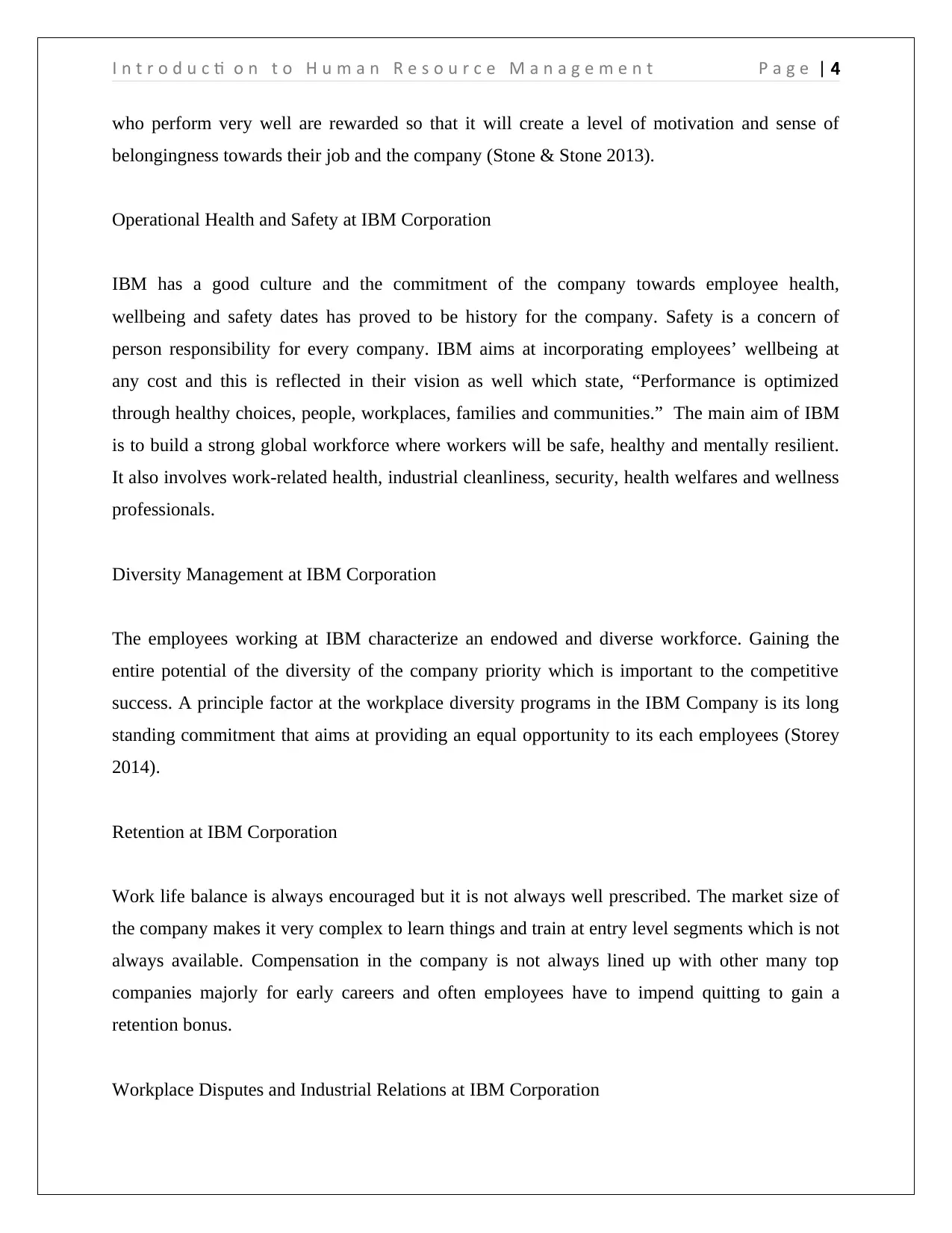
I n t r o d u c ti o n t o H u m a n R e s o u r c e M a n a g e m e n t P a g e | 4
who perform very well are rewarded so that it will create a level of motivation and sense of
belongingness towards their job and the company (Stone & Stone 2013).
Operational Health and Safety at IBM Corporation
IBM has a good culture and the commitment of the company towards employee health,
wellbeing and safety dates has proved to be history for the company. Safety is a concern of
person responsibility for every company. IBM aims at incorporating employees’ wellbeing at
any cost and this is reflected in their vision as well which state, “Performance is optimized
through healthy choices, people, workplaces, families and communities.” The main aim of IBM
is to build a strong global workforce where workers will be safe, healthy and mentally resilient.
It also involves work-related health, industrial cleanliness, security, health welfares and wellness
professionals.
Diversity Management at IBM Corporation
The employees working at IBM characterize an endowed and diverse workforce. Gaining the
entire potential of the diversity of the company priority which is important to the competitive
success. A principle factor at the workplace diversity programs in the IBM Company is its long
standing commitment that aims at providing an equal opportunity to its each employees (Storey
2014).
Retention at IBM Corporation
Work life balance is always encouraged but it is not always well prescribed. The market size of
the company makes it very complex to learn things and train at entry level segments which is not
always available. Compensation in the company is not always lined up with other many top
companies majorly for early careers and often employees have to impend quitting to gain a
retention bonus.
Workplace Disputes and Industrial Relations at IBM Corporation
who perform very well are rewarded so that it will create a level of motivation and sense of
belongingness towards their job and the company (Stone & Stone 2013).
Operational Health and Safety at IBM Corporation
IBM has a good culture and the commitment of the company towards employee health,
wellbeing and safety dates has proved to be history for the company. Safety is a concern of
person responsibility for every company. IBM aims at incorporating employees’ wellbeing at
any cost and this is reflected in their vision as well which state, “Performance is optimized
through healthy choices, people, workplaces, families and communities.” The main aim of IBM
is to build a strong global workforce where workers will be safe, healthy and mentally resilient.
It also involves work-related health, industrial cleanliness, security, health welfares and wellness
professionals.
Diversity Management at IBM Corporation
The employees working at IBM characterize an endowed and diverse workforce. Gaining the
entire potential of the diversity of the company priority which is important to the competitive
success. A principle factor at the workplace diversity programs in the IBM Company is its long
standing commitment that aims at providing an equal opportunity to its each employees (Storey
2014).
Retention at IBM Corporation
Work life balance is always encouraged but it is not always well prescribed. The market size of
the company makes it very complex to learn things and train at entry level segments which is not
always available. Compensation in the company is not always lined up with other many top
companies majorly for early careers and often employees have to impend quitting to gain a
retention bonus.
Workplace Disputes and Industrial Relations at IBM Corporation
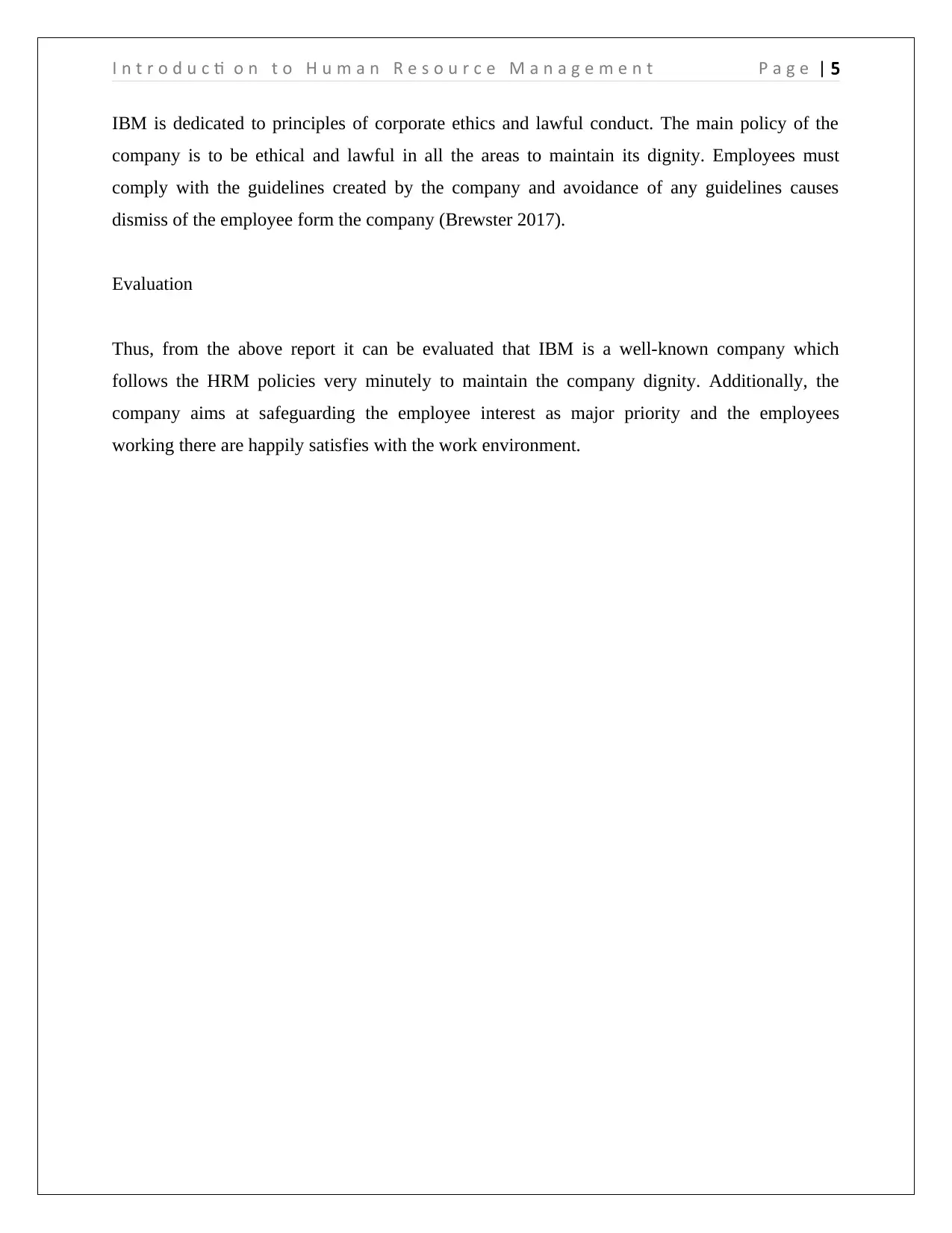
I n t r o d u c ti o n t o H u m a n R e s o u r c e M a n a g e m e n t P a g e | 5
IBM is dedicated to principles of corporate ethics and lawful conduct. The main policy of the
company is to be ethical and lawful in all the areas to maintain its dignity. Employees must
comply with the guidelines created by the company and avoidance of any guidelines causes
dismiss of the employee form the company (Brewster 2017).
Evaluation
Thus, from the above report it can be evaluated that IBM is a well-known company which
follows the HRM policies very minutely to maintain the company dignity. Additionally, the
company aims at safeguarding the employee interest as major priority and the employees
working there are happily satisfies with the work environment.
IBM is dedicated to principles of corporate ethics and lawful conduct. The main policy of the
company is to be ethical and lawful in all the areas to maintain its dignity. Employees must
comply with the guidelines created by the company and avoidance of any guidelines causes
dismiss of the employee form the company (Brewster 2017).
Evaluation
Thus, from the above report it can be evaluated that IBM is a well-known company which
follows the HRM policies very minutely to maintain the company dignity. Additionally, the
company aims at safeguarding the employee interest as major priority and the employees
working there are happily satisfies with the work environment.
⊘ This is a preview!⊘
Do you want full access?
Subscribe today to unlock all pages.

Trusted by 1+ million students worldwide
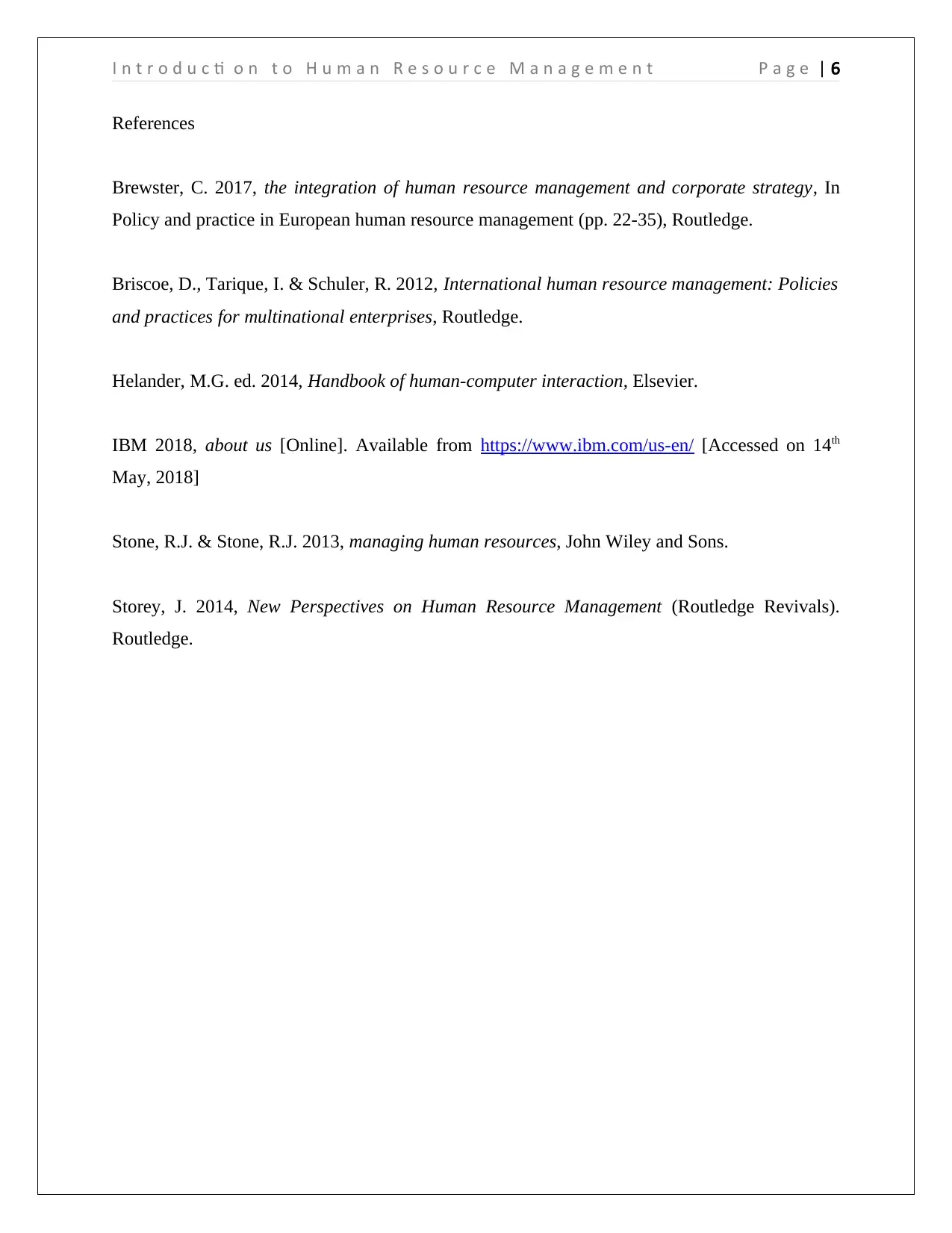
I n t r o d u c ti o n t o H u m a n R e s o u r c e M a n a g e m e n t P a g e | 6
References
Brewster, C. 2017, the integration of human resource management and corporate strategy, In
Policy and practice in European human resource management (pp. 22-35), Routledge.
Briscoe, D., Tarique, I. & Schuler, R. 2012, International human resource management: Policies
and practices for multinational enterprises, Routledge.
Helander, M.G. ed. 2014, Handbook of human-computer interaction, Elsevier.
IBM 2018, about us [Online]. Available from https://www.ibm.com/us-en/ [Accessed on 14th
May, 2018]
Stone, R.J. & Stone, R.J. 2013, managing human resources, John Wiley and Sons.
Storey, J. 2014, New Perspectives on Human Resource Management (Routledge Revivals).
Routledge.
References
Brewster, C. 2017, the integration of human resource management and corporate strategy, In
Policy and practice in European human resource management (pp. 22-35), Routledge.
Briscoe, D., Tarique, I. & Schuler, R. 2012, International human resource management: Policies
and practices for multinational enterprises, Routledge.
Helander, M.G. ed. 2014, Handbook of human-computer interaction, Elsevier.
IBM 2018, about us [Online]. Available from https://www.ibm.com/us-en/ [Accessed on 14th
May, 2018]
Stone, R.J. & Stone, R.J. 2013, managing human resources, John Wiley and Sons.
Storey, J. 2014, New Perspectives on Human Resource Management (Routledge Revivals).
Routledge.
Paraphrase This Document
Need a fresh take? Get an instant paraphrase of this document with our AI Paraphraser
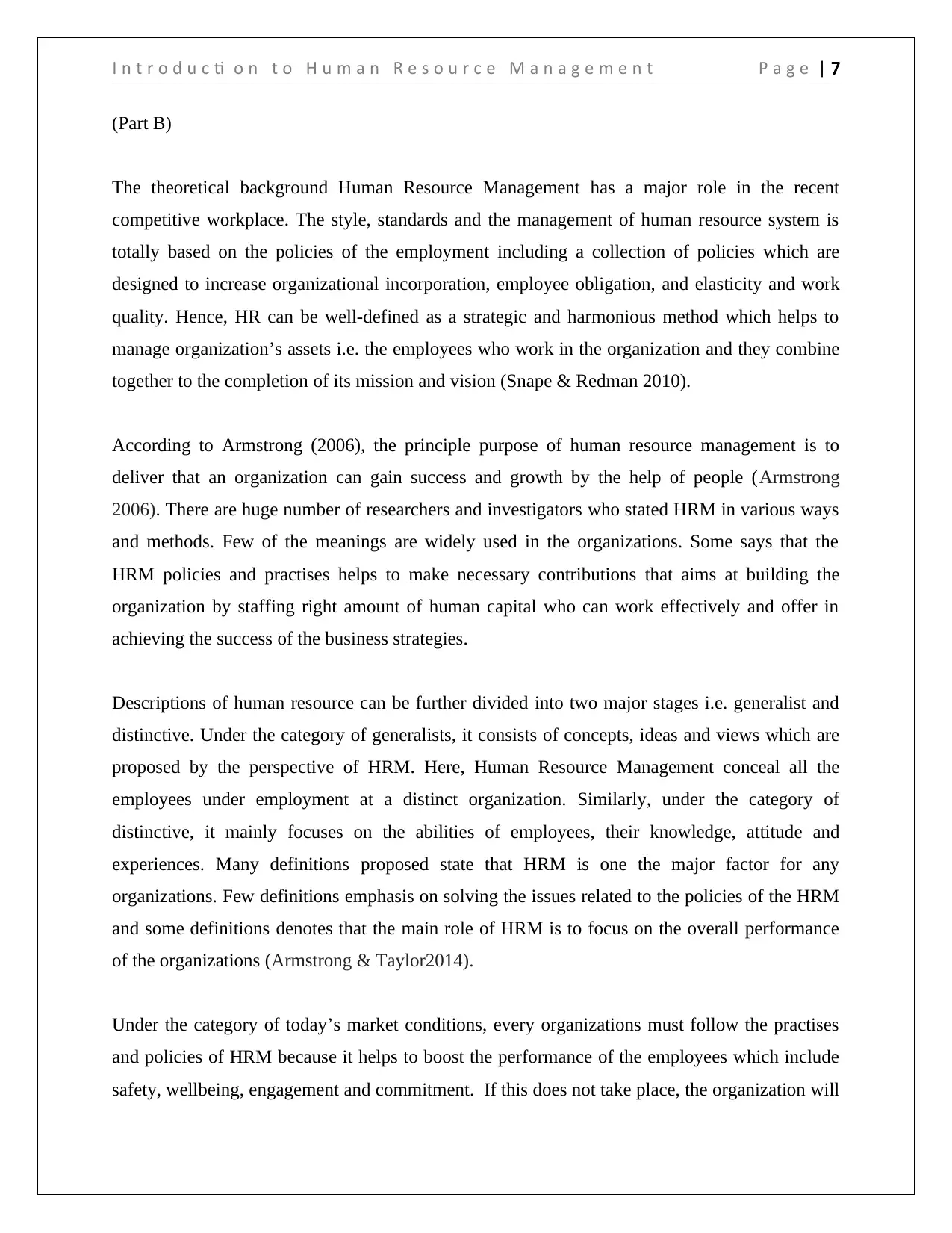
I n t r o d u c ti o n t o H u m a n R e s o u r c e M a n a g e m e n t P a g e | 7
(Part B)
The theoretical background Human Resource Management has a major role in the recent
competitive workplace. The style, standards and the management of human resource system is
totally based on the policies of the employment including a collection of policies which are
designed to increase organizational incorporation, employee obligation, and elasticity and work
quality. Hence, HR can be well-defined as a strategic and harmonious method which helps to
manage organization’s assets i.e. the employees who work in the organization and they combine
together to the completion of its mission and vision (Snape & Redman 2010).
According to Armstrong (2006), the principle purpose of human resource management is to
deliver that an organization can gain success and growth by the help of people (Armstrong
2006). There are huge number of researchers and investigators who stated HRM in various ways
and methods. Few of the meanings are widely used in the organizations. Some says that the
HRM policies and practises helps to make necessary contributions that aims at building the
organization by staffing right amount of human capital who can work effectively and offer in
achieving the success of the business strategies.
Descriptions of human resource can be further divided into two major stages i.e. generalist and
distinctive. Under the category of generalists, it consists of concepts, ideas and views which are
proposed by the perspective of HRM. Here, Human Resource Management conceal all the
employees under employment at a distinct organization. Similarly, under the category of
distinctive, it mainly focuses on the abilities of employees, their knowledge, attitude and
experiences. Many definitions proposed state that HRM is one the major factor for any
organizations. Few definitions emphasis on solving the issues related to the policies of the HRM
and some definitions denotes that the main role of HRM is to focus on the overall performance
of the organizations (Armstrong & Taylor2014).
Under the category of today’s market conditions, every organizations must follow the practises
and policies of HRM because it helps to boost the performance of the employees which include
safety, wellbeing, engagement and commitment. If this does not take place, the organization will
(Part B)
The theoretical background Human Resource Management has a major role in the recent
competitive workplace. The style, standards and the management of human resource system is
totally based on the policies of the employment including a collection of policies which are
designed to increase organizational incorporation, employee obligation, and elasticity and work
quality. Hence, HR can be well-defined as a strategic and harmonious method which helps to
manage organization’s assets i.e. the employees who work in the organization and they combine
together to the completion of its mission and vision (Snape & Redman 2010).
According to Armstrong (2006), the principle purpose of human resource management is to
deliver that an organization can gain success and growth by the help of people (Armstrong
2006). There are huge number of researchers and investigators who stated HRM in various ways
and methods. Few of the meanings are widely used in the organizations. Some says that the
HRM policies and practises helps to make necessary contributions that aims at building the
organization by staffing right amount of human capital who can work effectively and offer in
achieving the success of the business strategies.
Descriptions of human resource can be further divided into two major stages i.e. generalist and
distinctive. Under the category of generalists, it consists of concepts, ideas and views which are
proposed by the perspective of HRM. Here, Human Resource Management conceal all the
employees under employment at a distinct organization. Similarly, under the category of
distinctive, it mainly focuses on the abilities of employees, their knowledge, attitude and
experiences. Many definitions proposed state that HRM is one the major factor for any
organizations. Few definitions emphasis on solving the issues related to the policies of the HRM
and some definitions denotes that the main role of HRM is to focus on the overall performance
of the organizations (Armstrong & Taylor2014).
Under the category of today’s market conditions, every organizations must follow the practises
and policies of HRM because it helps to boost the performance of the employees which include
safety, wellbeing, engagement and commitment. If this does not take place, the organization will
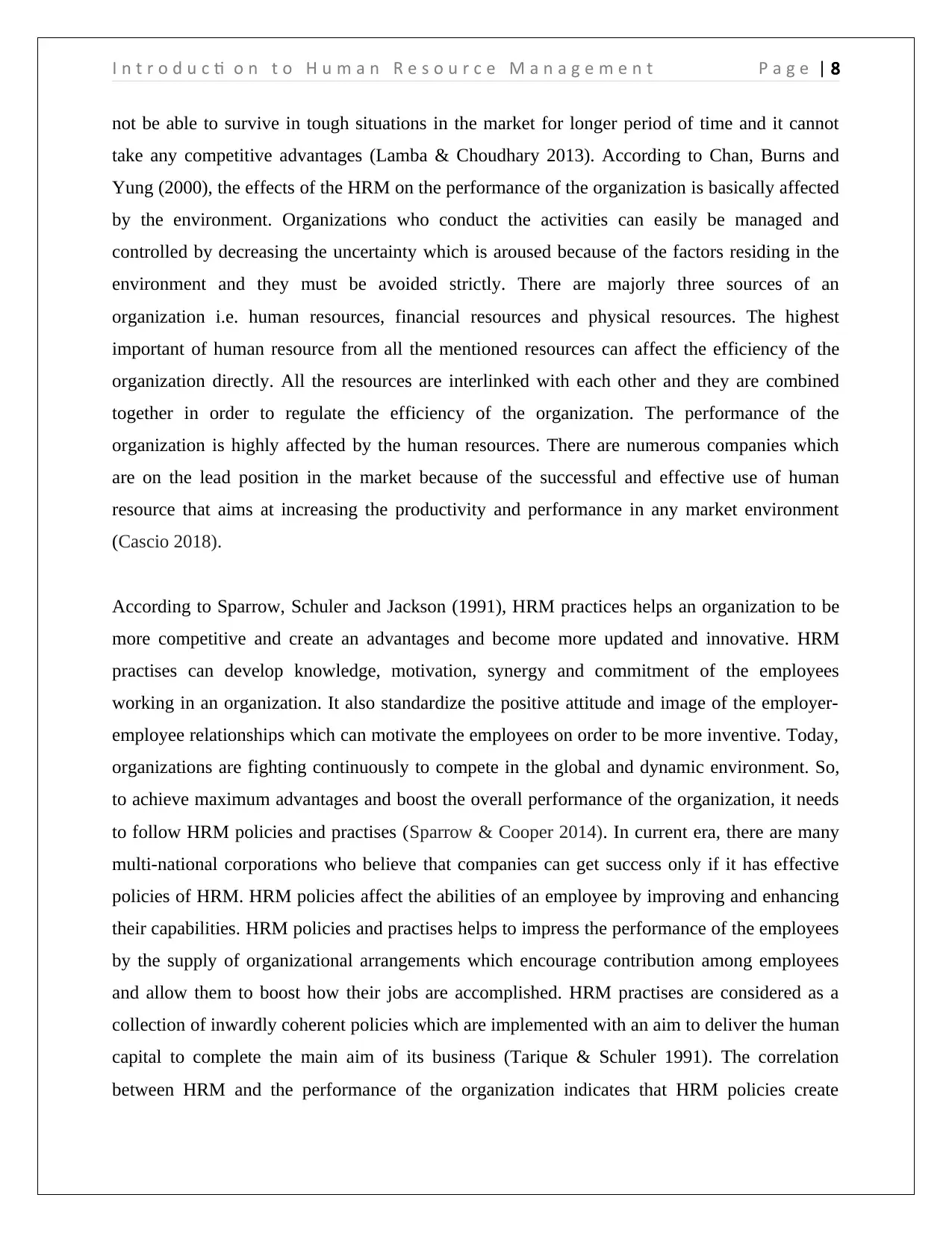
I n t r o d u c ti o n t o H u m a n R e s o u r c e M a n a g e m e n t P a g e | 8
not be able to survive in tough situations in the market for longer period of time and it cannot
take any competitive advantages (Lamba & Choudhary 2013). According to Chan, Burns and
Yung (2000), the effects of the HRM on the performance of the organization is basically affected
by the environment. Organizations who conduct the activities can easily be managed and
controlled by decreasing the uncertainty which is aroused because of the factors residing in the
environment and they must be avoided strictly. There are majorly three sources of an
organization i.e. human resources, financial resources and physical resources. The highest
important of human resource from all the mentioned resources can affect the efficiency of the
organization directly. All the resources are interlinked with each other and they are combined
together in order to regulate the efficiency of the organization. The performance of the
organization is highly affected by the human resources. There are numerous companies which
are on the lead position in the market because of the successful and effective use of human
resource that aims at increasing the productivity and performance in any market environment
(Cascio 2018).
According to Sparrow, Schuler and Jackson (1991), HRM practices helps an organization to be
more competitive and create an advantages and become more updated and innovative. HRM
practises can develop knowledge, motivation, synergy and commitment of the employees
working in an organization. It also standardize the positive attitude and image of the employer-
employee relationships which can motivate the employees on order to be more inventive. Today,
organizations are fighting continuously to compete in the global and dynamic environment. So,
to achieve maximum advantages and boost the overall performance of the organization, it needs
to follow HRM policies and practises (Sparrow & Cooper 2014). In current era, there are many
multi-national corporations who believe that companies can get success only if it has effective
policies of HRM. HRM policies affect the abilities of an employee by improving and enhancing
their capabilities. HRM policies and practises helps to impress the performance of the employees
by the supply of organizational arrangements which encourage contribution among employees
and allow them to boost how their jobs are accomplished. HRM practises are considered as a
collection of inwardly coherent policies which are implemented with an aim to deliver the human
capital to complete the main aim of its business (Tarique & Schuler 1991). The correlation
between HRM and the performance of the organization indicates that HRM policies create
not be able to survive in tough situations in the market for longer period of time and it cannot
take any competitive advantages (Lamba & Choudhary 2013). According to Chan, Burns and
Yung (2000), the effects of the HRM on the performance of the organization is basically affected
by the environment. Organizations who conduct the activities can easily be managed and
controlled by decreasing the uncertainty which is aroused because of the factors residing in the
environment and they must be avoided strictly. There are majorly three sources of an
organization i.e. human resources, financial resources and physical resources. The highest
important of human resource from all the mentioned resources can affect the efficiency of the
organization directly. All the resources are interlinked with each other and they are combined
together in order to regulate the efficiency of the organization. The performance of the
organization is highly affected by the human resources. There are numerous companies which
are on the lead position in the market because of the successful and effective use of human
resource that aims at increasing the productivity and performance in any market environment
(Cascio 2018).
According to Sparrow, Schuler and Jackson (1991), HRM practices helps an organization to be
more competitive and create an advantages and become more updated and innovative. HRM
practises can develop knowledge, motivation, synergy and commitment of the employees
working in an organization. It also standardize the positive attitude and image of the employer-
employee relationships which can motivate the employees on order to be more inventive. Today,
organizations are fighting continuously to compete in the global and dynamic environment. So,
to achieve maximum advantages and boost the overall performance of the organization, it needs
to follow HRM policies and practises (Sparrow & Cooper 2014). In current era, there are many
multi-national corporations who believe that companies can get success only if it has effective
policies of HRM. HRM policies affect the abilities of an employee by improving and enhancing
their capabilities. HRM policies and practises helps to impress the performance of the employees
by the supply of organizational arrangements which encourage contribution among employees
and allow them to boost how their jobs are accomplished. HRM practises are considered as a
collection of inwardly coherent policies which are implemented with an aim to deliver the human
capital to complete the main aim of its business (Tarique & Schuler 1991). The correlation
between HRM and the performance of the organization indicates that HRM policies create
⊘ This is a preview!⊘
Do you want full access?
Subscribe today to unlock all pages.

Trusted by 1+ million students worldwide
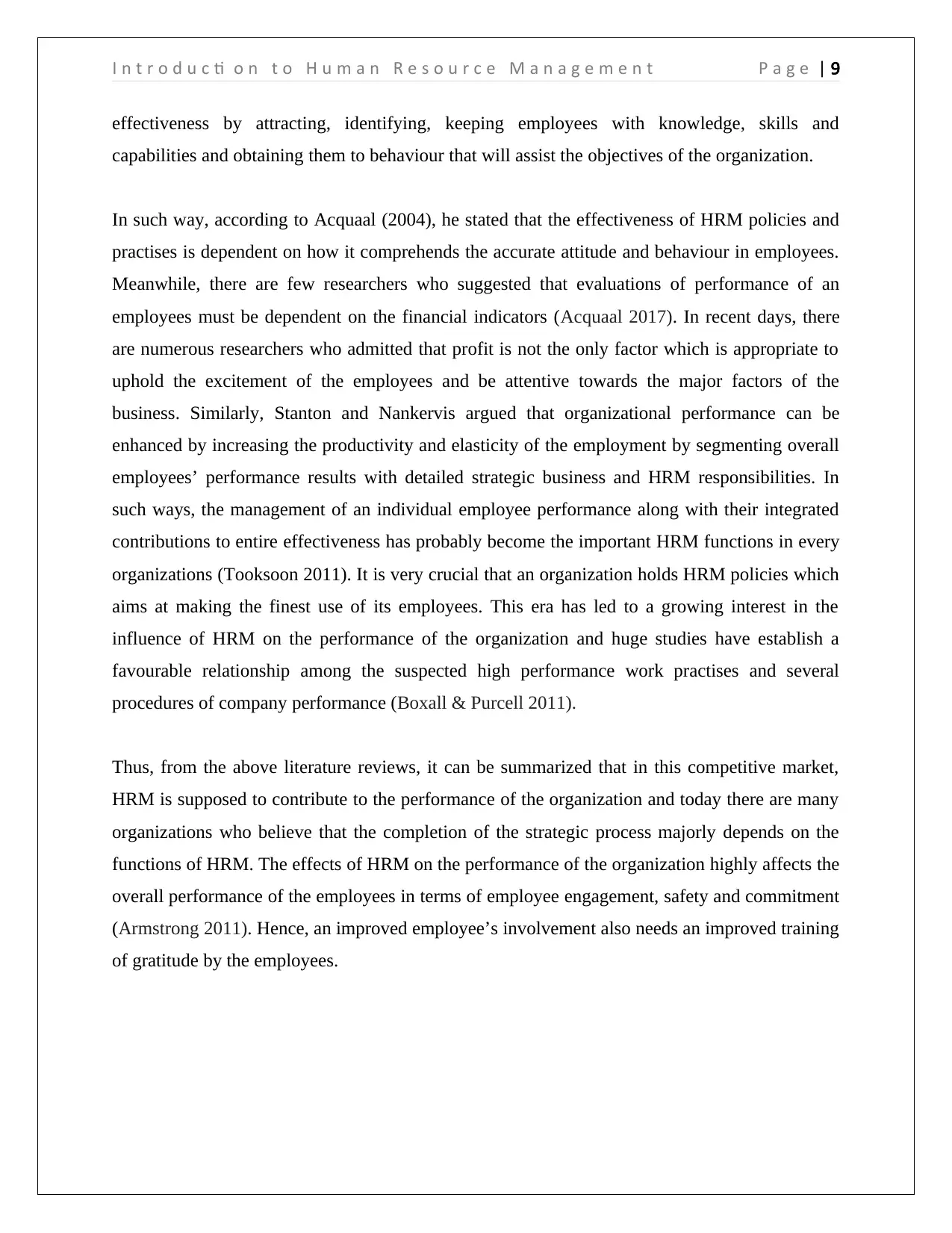
I n t r o d u c ti o n t o H u m a n R e s o u r c e M a n a g e m e n t P a g e | 9
effectiveness by attracting, identifying, keeping employees with knowledge, skills and
capabilities and obtaining them to behaviour that will assist the objectives of the organization.
In such way, according to Acquaal (2004), he stated that the effectiveness of HRM policies and
practises is dependent on how it comprehends the accurate attitude and behaviour in employees.
Meanwhile, there are few researchers who suggested that evaluations of performance of an
employees must be dependent on the financial indicators (Acquaal 2017). In recent days, there
are numerous researchers who admitted that profit is not the only factor which is appropriate to
uphold the excitement of the employees and be attentive towards the major factors of the
business. Similarly, Stanton and Nankervis argued that organizational performance can be
enhanced by increasing the productivity and elasticity of the employment by segmenting overall
employees’ performance results with detailed strategic business and HRM responsibilities. In
such ways, the management of an individual employee performance along with their integrated
contributions to entire effectiveness has probably become the important HRM functions in every
organizations (Tooksoon 2011). It is very crucial that an organization holds HRM policies which
aims at making the finest use of its employees. This era has led to a growing interest in the
influence of HRM on the performance of the organization and huge studies have establish a
favourable relationship among the suspected high performance work practises and several
procedures of company performance (Boxall & Purcell 2011).
Thus, from the above literature reviews, it can be summarized that in this competitive market,
HRM is supposed to contribute to the performance of the organization and today there are many
organizations who believe that the completion of the strategic process majorly depends on the
functions of HRM. The effects of HRM on the performance of the organization highly affects the
overall performance of the employees in terms of employee engagement, safety and commitment
(Armstrong 2011). Hence, an improved employee’s involvement also needs an improved training
of gratitude by the employees.
effectiveness by attracting, identifying, keeping employees with knowledge, skills and
capabilities and obtaining them to behaviour that will assist the objectives of the organization.
In such way, according to Acquaal (2004), he stated that the effectiveness of HRM policies and
practises is dependent on how it comprehends the accurate attitude and behaviour in employees.
Meanwhile, there are few researchers who suggested that evaluations of performance of an
employees must be dependent on the financial indicators (Acquaal 2017). In recent days, there
are numerous researchers who admitted that profit is not the only factor which is appropriate to
uphold the excitement of the employees and be attentive towards the major factors of the
business. Similarly, Stanton and Nankervis argued that organizational performance can be
enhanced by increasing the productivity and elasticity of the employment by segmenting overall
employees’ performance results with detailed strategic business and HRM responsibilities. In
such ways, the management of an individual employee performance along with their integrated
contributions to entire effectiveness has probably become the important HRM functions in every
organizations (Tooksoon 2011). It is very crucial that an organization holds HRM policies which
aims at making the finest use of its employees. This era has led to a growing interest in the
influence of HRM on the performance of the organization and huge studies have establish a
favourable relationship among the suspected high performance work practises and several
procedures of company performance (Boxall & Purcell 2011).
Thus, from the above literature reviews, it can be summarized that in this competitive market,
HRM is supposed to contribute to the performance of the organization and today there are many
organizations who believe that the completion of the strategic process majorly depends on the
functions of HRM. The effects of HRM on the performance of the organization highly affects the
overall performance of the employees in terms of employee engagement, safety and commitment
(Armstrong 2011). Hence, an improved employee’s involvement also needs an improved training
of gratitude by the employees.
Paraphrase This Document
Need a fresh take? Get an instant paraphrase of this document with our AI Paraphraser
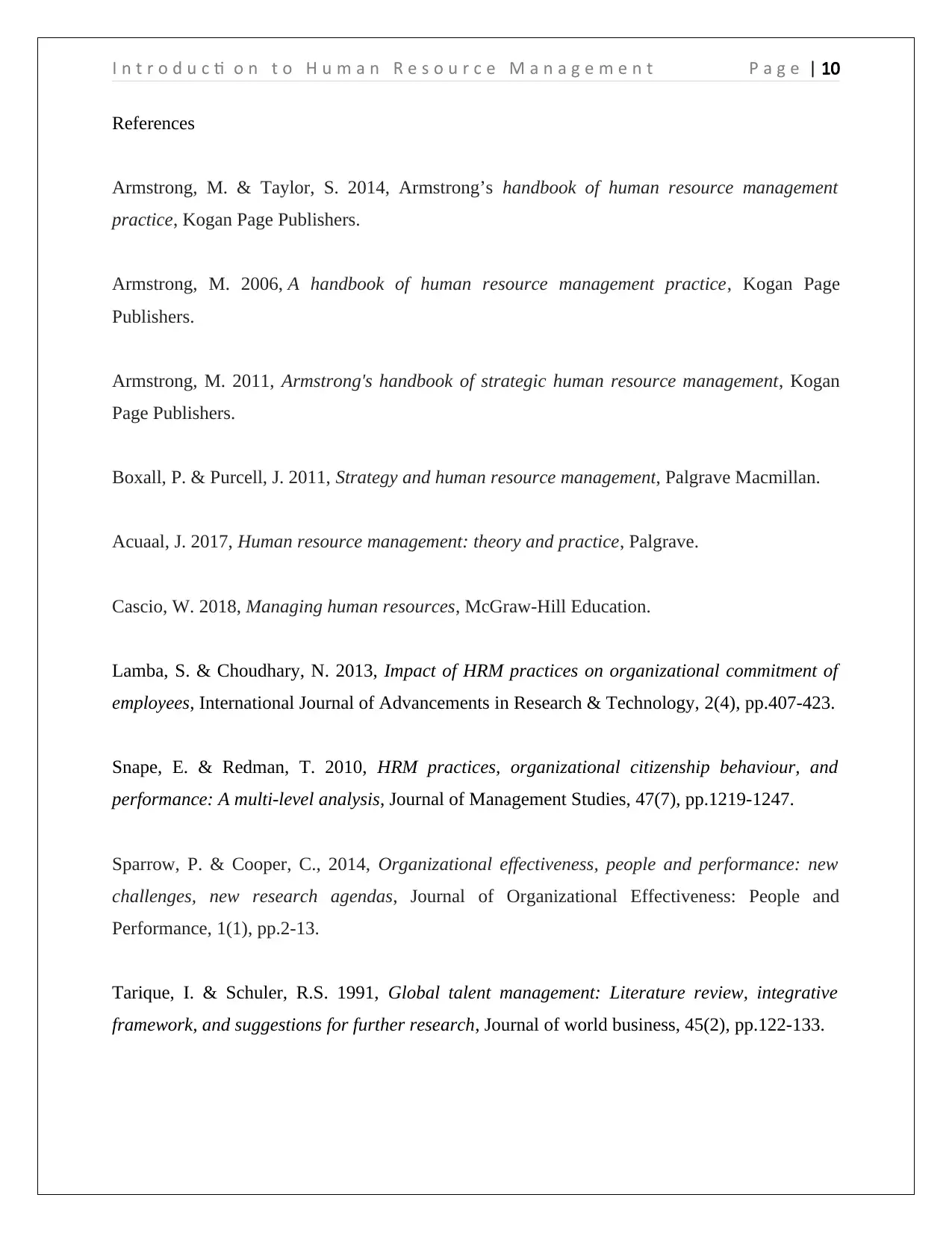
I n t r o d u c ti o n t o H u m a n R e s o u r c e M a n a g e m e n t P a g e | 10
References
Armstrong, M. & Taylor, S. 2014, Armstrong’s handbook of human resource management
practice, Kogan Page Publishers.
Armstrong, M. 2006, A handbook of human resource management practice, Kogan Page
Publishers.
Armstrong, M. 2011, Armstrong's handbook of strategic human resource management, Kogan
Page Publishers.
Boxall, P. & Purcell, J. 2011, Strategy and human resource management, Palgrave Macmillan.
Acuaal, J. 2017, Human resource management: theory and practice, Palgrave.
Cascio, W. 2018, Managing human resources, McGraw-Hill Education.
Lamba, S. & Choudhary, N. 2013, Impact of HRM practices on organizational commitment of
employees, International Journal of Advancements in Research & Technology, 2(4), pp.407-423.
Snape, E. & Redman, T. 2010, HRM practices, organizational citizenship behaviour, and
performance: A multi‐level analysis, Journal of Management Studies, 47(7), pp.1219-1247.
Sparrow, P. & Cooper, C., 2014, Organizational effectiveness, people and performance: new
challenges, new research agendas, Journal of Organizational Effectiveness: People and
Performance, 1(1), pp.2-13.
Tarique, I. & Schuler, R.S. 1991, Global talent management: Literature review, integrative
framework, and suggestions for further research, Journal of world business, 45(2), pp.122-133.
References
Armstrong, M. & Taylor, S. 2014, Armstrong’s handbook of human resource management
practice, Kogan Page Publishers.
Armstrong, M. 2006, A handbook of human resource management practice, Kogan Page
Publishers.
Armstrong, M. 2011, Armstrong's handbook of strategic human resource management, Kogan
Page Publishers.
Boxall, P. & Purcell, J. 2011, Strategy and human resource management, Palgrave Macmillan.
Acuaal, J. 2017, Human resource management: theory and practice, Palgrave.
Cascio, W. 2018, Managing human resources, McGraw-Hill Education.
Lamba, S. & Choudhary, N. 2013, Impact of HRM practices on organizational commitment of
employees, International Journal of Advancements in Research & Technology, 2(4), pp.407-423.
Snape, E. & Redman, T. 2010, HRM practices, organizational citizenship behaviour, and
performance: A multi‐level analysis, Journal of Management Studies, 47(7), pp.1219-1247.
Sparrow, P. & Cooper, C., 2014, Organizational effectiveness, people and performance: new
challenges, new research agendas, Journal of Organizational Effectiveness: People and
Performance, 1(1), pp.2-13.
Tarique, I. & Schuler, R.S. 1991, Global talent management: Literature review, integrative
framework, and suggestions for further research, Journal of world business, 45(2), pp.122-133.
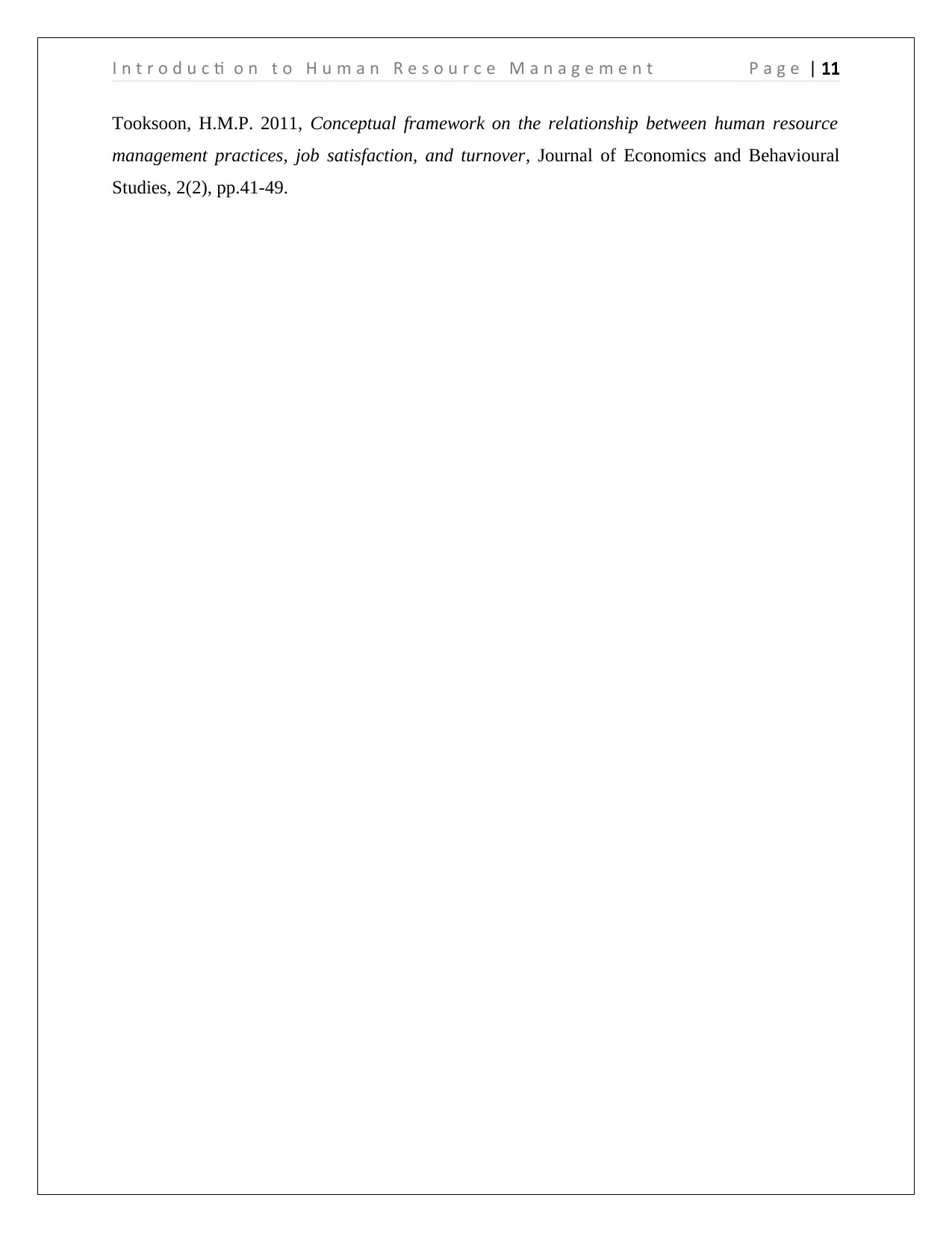
I n t r o d u c ti o n t o H u m a n R e s o u r c e M a n a g e m e n t P a g e | 11
Tooksoon, H.M.P. 2011, Conceptual framework on the relationship between human resource
management practices, job satisfaction, and turnover, Journal of Economics and Behavioural
Studies, 2(2), pp.41-49.
Tooksoon, H.M.P. 2011, Conceptual framework on the relationship between human resource
management practices, job satisfaction, and turnover, Journal of Economics and Behavioural
Studies, 2(2), pp.41-49.
⊘ This is a preview!⊘
Do you want full access?
Subscribe today to unlock all pages.

Trusted by 1+ million students worldwide
1 out of 12
Related Documents
Your All-in-One AI-Powered Toolkit for Academic Success.
+13062052269
info@desklib.com
Available 24*7 on WhatsApp / Email
![[object Object]](/_next/static/media/star-bottom.7253800d.svg)
Unlock your academic potential
Copyright © 2020–2025 A2Z Services. All Rights Reserved. Developed and managed by ZUCOL.





